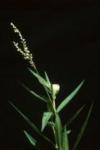Latin name
Persicaria hydropiper (L.) Spach.
Family
Polygonaceae
Common name(s)
Marsh-pepper smartweed, water pepper
Synonym(s)
Polygonum hydropiper L. (basionym), P. schinzii J. Schust., Persicaria hydropiper (L.) Opiz, P. hydropiper var. vulgaris (Meisn.) Ohki, P. vernalis Nakai
Geographical distribution
Asia: China (including Taiwan), Japan, and Korea.
South and Southeast Asia: Bangladesh, India, Indonesia, Malaysia, and Nepal.
Rest of the world: Afghanistan, Australia, Austria, Belgium, Brazil, Canada, Colombia, England, Finland, Germany, Greece, Honduras, Hungary, Iran, Iraq, Ireland, Italy, Jordan, Mexico, Netherlands, New Zealand, Poland, Portugal, Soviet Union, Sweden, Turkey, United States, and Yugoslavia.
Morphology
Erect or ascending annual herb to 60—cm—tall.
Stem: reddish purple or red, branched and swollen at nodes.
Leaf: 5—10—cm—long, with short petiole, lanceolate or oblanceolate, rough margins, and dotted with depressed glands on both surfaces; tubular sheath (ochrea) at leaf base, 1—2—cm—long, with hairy margins.
Inflorescence: loose spikes borne in leaf axils or in stem terminals; perianth 4—5 lobed, 3—3.5—mm—long, greenish yellow and pink above.
Fruit: 3—mm—long nut, biconvex or 3—angled, opaque, finely granulate and dark brown.
Biology and ecology
Polygonum hydropiper grows along streams, sunny wet places, and lowland rice fields. Self-pollinating and each plant can produce 3,000 seeds.
Agricultural importance
Weed of rice, maize, wheat, barley, leguminous crops, vegetables, tobacco and sugarcane.
Management
Cultural control: hand pulling or tillage can control the weed, though cut portions can readily regrow.
Chemical control: Cyhalofop in combination of either bentazon or pendimethalin reported to give good control in rice.
Selected references
Backer CA, Van Den Brink RCB. 1963. Flora of Java (Spermatophytes only). Groningen (The Netherlands): NVP Noordhoff. Vol. 1. 648 p.Caton BP, Mortimer M, Hill JE. 2004. Weeds of rice in Asia. Los Baños (Philippines): International Rice Research Institute. 116 p.Datta S, Bannerjee A. 1973. Weight and number of weed seeds. Proceedings of the 4th Asian-Pacific Weed Science Society Conference. 1:87-91.Holm LG, Doll J, Holm E, Pancho JV, Herberger JP, 1997. World weeds: natural histories and distribution. New York (USA): John Wiley & Sons Inc.1129 p.Holm L, Pancho JV, Herberger JP, Plucknett DL. 1979. A geographical atlas of world weeds. New York (USA): John Wiley & Sons, Inc. 391 p.Liu T, Ying S, Lai M. 1976. Polygonaceae. Flora Taiwan 2: 259-292.Moody K. 1989. Weeds reported in South and Southeast Asia. Manila (Philippines): International Rice Research Institute. 442 p.Nakamura S. 1970. Germination of Polygonum hydropiper L. seeds. Bull. Fac. Agric. Yamaguti Univ. 21:78-83.Park TS, Park JE, Ryu GH, Lee IY, Lee HK, Lee JO. 1995. Effective weed control in direct-seeded rice under dry fields. K. J. Weed Sci. 5(2):99-104.
Contributors
JLA Catindig, RT Lubigan, and DE Johnson
